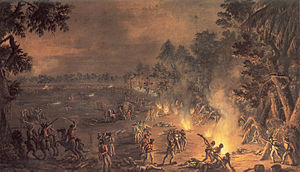Battle of Paoli
| Battle of Paoli | |||||||
|---|---|---|---|---|---|---|---|
| Part of the American Revolutionary War | |||||||
 A Dreadful scene of havock by Xavier della Gatta, 1782, commissioned for a British officer who participated in the attack |
|||||||
|
|||||||
| Belligerents | |||||||
|
|
|
||||||
| Commanders and leaders | |||||||
|
|
|
||||||
| Strength | |||||||
|
2,500 men
|
1,200 men engaged 600 in support 2 miles away |
||||||
| Casualties and losses | |||||||
| 201 killed or wounded 71 captured |
4 killed, 7 wounded |
||||||
|
Paoli Battlefield Site and Parade Grounds
|
|

The present-day monument at the site of the battle
|
|
| Location | Roughly bounded by Warren, and Monument Aves., and Sugartown Rd., Malvern, Pennsylvania |
|---|---|
| Coordinates | 40°01′47″N 75°31′06″W / 40.02972°N 75.51833°WCoordinates: 40°01′47″N 75°31′06″W / 40.02972°N 75.51833°W |
| Area | 62.2 acres (25.2 ha) |
| Built | 1817, 1877 |
| Architect | John T. Windrim, Palmer C. Hughes |
| Architectural style | Colonial Revival, Late 19th And 20th Century Revivals |
| NRHP Reference # | 97001248 |
| Added to NRHP | October 23, 1997 |
2,500 men
The Battle of Paoli (also known as the Battle of Paoli Tavern or the Paoli Massacre) was a battle in the Philadelphia campaign of the American Revolutionary War fought on September 20, 1777, in the area surrounding present-day Malvern, Pennsylvania. Following the American retreats at the Battle of Brandywine and the Battle of the Clouds, George Washington left a force under Brigadier General Anthony Wayne behind to monitor and harass the British as they prepared to move on the revolutionary capital of Philadelphia. On the evening of September 20, British forces under Major General Charles Grey led a surprise attack on Wayne's encampment near the Paoli Tavern. Although there were relatively few American casualties, claims were made that the British took no prisoners and granted no quarter, and the engagement became known as the "Paoli Massacre."
After the American defeat at the Battle of Brandywine, American Major General George Washington was intent on accomplishing two tasks. He wanted to protect Philadelphia from British forces under the command of Lieutenant General William Howe, and he needed to replenish the rapidly dwindling supplies and munitions stored in Reading, Pennsylvania. Washington withdrew across the Schuylkill River, marched through Philadelphia, and headed northwest. Since the Schuylkill was fordable only far upstream starting at Matson's Ford (present-day Conshohocken), Washington could protect both the capital and the vital supply areas to the west from behind the river barrier. Washington reconsidered, and recrossed the river to face the British, who had moved little since Brandywine, due to a shortage of wagons to carry their wounded and their baggage. After the Battle of the Clouds was aborted by bad weather on September 16, Washington again withdrew across the Schuylkill, leaving Brigadier General "Mad" Anthony Wayne's Pennsylvania Division at Chester, Pennsylvania. When the British columns passed by, Wayne followed, under orders from Washington to harass the British and attempt to capture all or part of their baggage train.
...
Wikipedia


